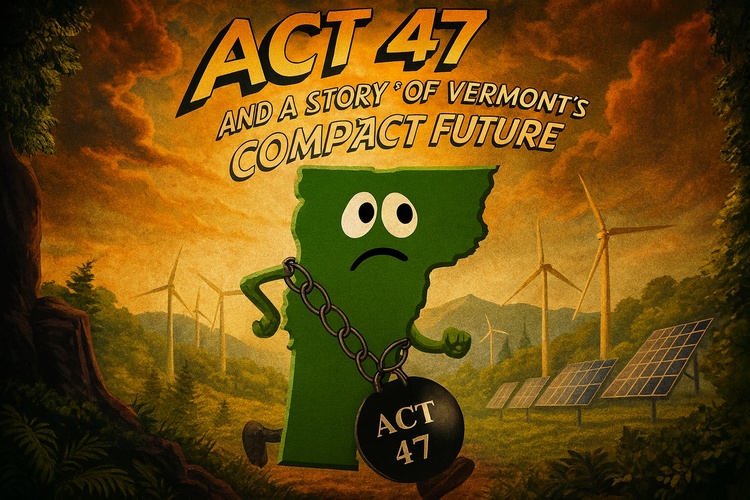Five advocacy organizations drive much of Vermont’s modern environmental and energy policy — and their influence reaches deep into nearly every corner of the State House. Together, they form the lobbying core behind Vermont’s most ambitious and controversial regulatory efforts: the Global Warming Solutions Act, the Clean Heat Standard, the Clean Water Act, and the Three-Acre Rule.
Each of those measures restructured key parts of the state’s economy — from energy distribution to land use and storm-water management — and each moved forward under the steady pressure of a small, disciplined coalition that dominates Montpelier’s lobbying ecosystem.
The Five Power Hubs
| Rank | Organization / Lobbying Group | # Registered Lobbyists | Primary Focus / Alignment |
|---|---|---|---|
| 1 | VPIRG – Vermont Public Interest Research Group | 14 | Progressive environmental and consumer advocacy; renewable mandates and regulatory expansion |
| 2 | VNRC – Vermont Natural Resources Council | 12 | Land-use and water-quality policy; coordinates closely with Vermont Conservation Voters |
| 3 | Energy Action Network (EAN) | 11–18 (network-affiliated) | Coalition promoting carbon-reduction targets, electrification, and clean-energy transitions |
| 4 | Conservation Law Foundation (CLF) | 9 | Regional law group; litigates and lobbies on clean water, climate, and emissions |
| 5 | Vermont Conservation Voters (VCV) | 6 | Political arm of VNRC; campaign scorecards and electoral backing for allied legislators |
Together, these five organizations account for roughly 50 registered lobbyists, making them the most concentrated policy bloc in Montpelier. Their collective alignment — environmental, progressive, and regulatory — exerts disproportionate pressure on state energy and land-use lawmaking.
The Legislative Gravity They Orbit
The Global Warming Solutions Act (GWSA) of 2020 created legally binding carbon-reduction targets and empowered citizens or organizations to sue the state if benchmarks are missed — a framework heavily supported by VPIRG, VNRC, and EAN.
The Clean Heat Standard, now in phased implementation, compels fossil-fuel distributors to finance heat-pump conversions and weatherization programs.
The Clean Water Act and Three-Acre Rule tighten runoff controls and expand permitting across thousands of developed parcels statewide.
Each of these policies originated or advanced under sustained advocacy from this same environmental network. Most share not just lobbyists but even office space, legal counsel, and campaign coordination.
A Legislature Outnumbered
The Vermont General Assembly holds 180 seats — 108 Democrats and Progressives combined, 69 Republicans, and 3 Independents. The partisan balance already leans about 3-to-2 toward the left.
Layered over that is the lobbying population: 461 active lobbyists registered for the 2025–26 biennium — roughly 2.6 lobbyists for every lawmaker. (The Vermont Secretary of State’s website lists 567 lobbyist records for the 2025–26 biennium, though only 461 are currently active.)
But the ideological distribution isn’t even. Keyword analysis of every lobbyist’s listed “subject matter” shows approximately 70 percent working in issue areas aligned with left-of-center priorities such as renewable energy, healthcare, labor, housing, and social policy. About 30 percent represent right-leaning, neutral, or industry-specific interests like agriculture, firearms, or taxation.
When those alignments are weighted against the Legislature’s composition, the functional ratio of influence tilts roughly 3½ to 1 in favor of the progressive bloc — a combination of numerical majority and ideological reinforcement.
🍁 Make a One-Time Contribution — Stand Up for Accountability in Vermont 🍁
Where the Lobbying Lives
The registry shows just how concentrated advocacy has become:
| Rank | Subject Area | Approx. Lobbyists |
|---|---|---|
| 1 | Business / commerce | 536 |
| 2 | Health & health care | 140 |
| 3 | Environmental | 69 |
| 4 | Education | 67 |
| 5 | Energy | 61 |
| 6 | Climate change | 49 |
| 7 | Telecommunications | 49 |
| 8 | Social / human services | 47 |
| 9 | Insurance | 39 |
| 10 | Agriculture | 32 |
“Business” dominates by raw count — though that label often includes renewable-energy developers, insurers, and healthcare systems, not just traditional commerce. The next-largest clusters — healthcare, education, environment, and energy — map directly to sectors where the state exerts heavy regulatory control and distributes major funding.
Right-leaning or rural concerns such as agriculture, property rights, and small enterprise register far fewer active lobbyists, leaving many policy debates one-sided before they begin.
The Quiet Mechanics of Influence
Lobbying in Vermont is less about cash than constancy. The same handful of firms and advocates appear year after year before the same committees, building relationships and supplying draft language for complex bills. As one legislator put it, some lobbyists are in those committee rooms so regularly that they even have their own seat — an unspoken expectation that the spot will be waiting for them each morning.
Committee chairs — almost all drawn from the Democratic-Progressive bloc — often rely on these groups for research and expert testimony, giving them effective gatekeeper status over what legislation advances.
That doesn’t necessarily imply corruption; Vermont’s disclosure laws remain among the strictest in New England. But it does mean that the bandwidth of policymaking is finite, and most of it is occupied by advocates clustered on one side of the ideological spectrum.
A Growing Industry
In 1969, Vermont listed 63 registered lobbyists. By 1982 there were 152. In 2018, 452. The current 461 continues the upward curve.
Over that same half-century, the Legislature has held steady at 180 members — meaning the ratio of lobbyists to lawmakers has ballooned from one-third to nearly three-to-one.
Who Benefits, and Who Listens
The data don’t show ideological intent, only declared subject matter, but patterns emerge. Issues such as climate change, equity, education, and public health appear far more often than tax relief, property rights, or firearms. Many of the state’s largest and best-funded advocacy organizations — from healthcare associations to environmental alliances — operate in sync with the dominant legislative bloc.
Meanwhile, groups that typically advocate from the right — sportsmen’s federations, energy-price reformers, or business-tax advocates — operate on the margins, often with fewer registered lobbyists and limited budgets.
The picture that emerges is less about explicit partisanship than about structural gravity: the people writing laws hear most often from those whose interests align with the ruling majority’s priorities.
Why It Matters
For citizens watching bills like the Clean Heat Standard or future water-quality mandates, these numbers explain the persistent policy momentum. Legislators aren’t just negotiating among themselves; they’re working inside a pressure system where the most coordinated, well-funded advocacy networks already agree on direction and pace.
Other sectors — business coalitions, chambers of commerce, or rural associations — maintain a presence but rarely match the environmental bloc’s discipline or reach. Their influence tends to fragment across economic niches, while the environmental organizations operate with shared goals and messaging.
Montpelier’s landscape today is defined less by partisan brawls than by the gravitational pull of the five environmental powerhouses that have learned to move in concert. For lawmakers, the question isn’t whether these groups shape policy — it’s how much oxygen remains for anyone else.
When was the last time you worried about what kind of car your neighbor drove — or whether they heated their house with oil or electricity?
Dave Soulia | FYIVT
You can find FYIVT on YouTube | X(Twitter) | Facebook | Parler (@fyivt) | Gab | Instagram
#fyivt #VermontPolitics #Lobbying #EnvironmentalPolicy
Support Us for as Little as $5 – Get In The Fight!!
Make a Big Impact with $25/month—Become a Premium Supporter!
Join the Top Tier of Supporters with $50/month—Become a SUPER Supporter!








Leave a Reply